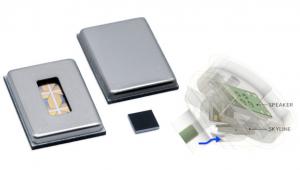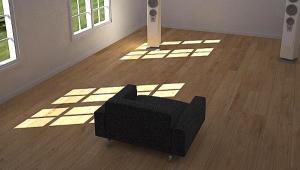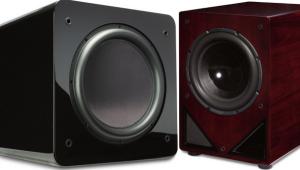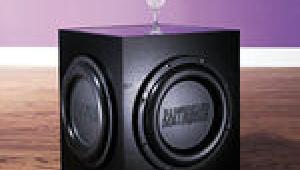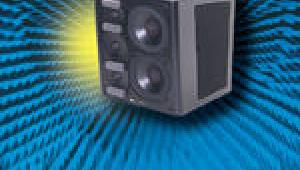Chris Hagen, Acoustic Systems Development Engineer, Velodyne
 Chris Hagen is acoustic systems development engineer for Velodyne, a company that, despite its recent forays into headphones, has been primarily a subwoofer specialist since its founding in 1983. Chris has also worked as an engineer for the consumer division of JBL, and for M&K Sound. Excerpts from this interview appear in the feature story “Subwoofers: The Guts and the Glory.”
Chris Hagen is acoustic systems development engineer for Velodyne, a company that, despite its recent forays into headphones, has been primarily a subwoofer specialist since its founding in 1983. Chris has also worked as an engineer for the consumer division of JBL, and for M&K Sound. Excerpts from this interview appear in the feature story “Subwoofers: The Guts and the Glory.”
S&V: What’s the most important in a subwoofer: the driver, the enclosure, or the amplifier?
CH: Being a system engineer, I believe all of it’s important. A poor-quality part in just one of the areas can mess up the whole product. For instance, no sub with a leaky enclosure is going to sound good no matter what amp or driver you use. Or if you tune the sub in an environment [room] that’s not appropriate to tune in, it’s going to sound bad regardless of the components you use.
S&V: Do you have a preference for ported, sealed, or passive-radiator subwoofers? How do the design decisions differ among those three?
CH: What has typically happened is, it’s more of a decision between the engineer and the product development arm that has an idea of the need for the product. If it needs to be efficient and cost-effective, and maybe you don’t have the budget for a lot of power, then you lean toward having assistance devices like a port or passive radiator. If cost is no object, it’s typically better to get a less steep low-frequency roll-off using a sealed enclosure and then throw a lot of power at it. Our more expensive subwoofers are typically sealed enclosures with 1,200-watt amps.
S&V: What goals do you set when you tune the digital signal processors on your subwoofers? Do you make the response flat, or do you put in bumps in the response to give the sub a certain sound?
CH: When you do EQ on a DSP, you’re creating a change to the frequency response of the signal that’s coming in, very much like a graphic or parametric EQ. It’s a lot easier that way than playing around with resistor or capacitor values, as you would if you didn’t have DSP and had to use analog circuitry. For the end user, the result is about the same, but it turns out the digital costs less because more of the work is done in the programming.
My process is to go for flat response in a known environment, such as an anechoic chamber or 2-pi [half-space or ground-plane] measurements. Then we get the sub into our sound room and listen to it, and we make some adjustments based on that. We don’t necessarily just stick with flat all the time. It depends on what we think the expectations are of people shopping for that kind of a product. That’s why we put a lot of capability into our subs: the four presets [rock, jazz/classical, movies and game] in the less-expensive subs, the six presets and auto EQ in our Digital Drive Plus subs. We don’t want to impose a particular curve on anyone, but flat in an anechoic environment is always our starting point.
S&V: How do you feel about the high-efficiency subwoofer amplifier technologies out there, such as Class D, Class G, and Class H? Do you feel a traditional Class AB amp offers better sound? Or do you feel Class AB is still viable?
CH: We have to remember that a watt is a watt. If you compare equal-caliber amps, you shouldn’t hear a difference. Also, if a subwoofer is set up right, to keep you out of a certain area of operation [such as overdriving the subwoofer at low frequencies], you won’t hear a difference in the amplifier. With Class AB, you tend to be pushing into the maximum voltage of the power supply rail and it can get close to clipping, but the guy who sets it up should know to keep you out of there.
“If a subwoofer is set up right, to keep you out of a certain area of operation [such as overdriving the subwoofer at low frequencies], you won’t hear a difference in the amplifier.”
It also gets into efficiency. The audio industry doesn’t have the luxury of using inefficient amplifiers to drive speakers anymore. We have to be working toward more efficient speakers and amplifiers. I wouldn’t say Class D or H is the only way, but it’s definitely going there. As we go into the future we’re seeing dwindling resources. If Class D is designed into something and you’re properly limiting input and setting it up for the appropriate power output, it’s much simpler and more efficient.
S&V: What kinds of measurements do you do to evaluate a subwoofer design?
CH: I start with the basics. The low-frequency extension and output are driven by pure driver excursion, or whatever the thing is that’s moving the air to create the bass. And I look at maximum SPL [sound pressure level] and distortion. None of these are more important than anything else. Velodyne has been the flag-waver for low-distortion subs and we’re not going to stop. Our ideal is under 10% THD [total harmonic distortion] at max output, which we’ve achieved with the Digital Drive Plus line. We believe in keeping distortion as low as possible. We’re trying to make reproducers, not producers, and anything with a lot of distortion is producing a sound of its own.
Our methods don’t exactly match CEA-2010 method out at the moment; we follow our own way because we’ve been doing this for a long time. We’re trying to blend the CEA-2010 method into our process, though.
S&V: Tell us a little bit about the auto EQ circuitry built into Velodyne’s Digital Drive Plus subs. Also, how do you feel about the automatic EQ technologies that are built into receivers and pre/pros?
CH: Our system looks for peaks and dips in the in-room response, and also for multiples—i.e., a room mode that occurs at, say, 35 Hz, then 70 Hz, etc . We have eight EQ bands. The system comes with a microphone that you plug into the sub. It will adjust, measure, readjust, and remeasure until the response is flat or at least a lot flatter than it was. We stop after 12 sweeps, so you don’t have to run off to McDonalds or something when the sub’s calibrating itself.
We think the external systems built into receivers are a great advance, in that they help get the room tuned and give the end user a more common experience. But we have noticed—and it doesn’t seem to be tied to any particular system—that when the auto EQ of the receiver is run first, and the sub’s just taken out of the box and put down on the floor with no crossover work done, you’ll get a big lump at the crossover point. The receiver will tend to try to fix that by turning sub down. It might be –10 dB at the same frequency where the satellites are at 0 dB. Then we get the call, “I can’t hear your subwoofer!”
We’ve found that with our auto EQ systems, if the end user goes through setup with the sub first, and then uses the auto EQ afterward to get something that’s reasonably smoothish, the in-room response at the crossover point will look more like a full-range speaker rather than a speaker with a big bump that needs fixing.
S&V: Would you recommend S&V readers buy four smaller subs, two midsized subs or one large sub, if the price for the different packages were about the same?
CH: It would depend on the size of the room. Typically one big sub will go deeper, but I like multiple smaller ones because you can load the room better. We’ve found that using two in the corners drives all the modes and the response can get choppy. We’ve found that putting one sub along the center of the wall and one in the corner does more to smooth out the room modes. We tend to lean toward multiples. But a single 12-inch optimal sub with a cast frame and 3-inch voice coil is better than four small subs, because those small ones will probably have stamped frames and not much excursion.
“We’ve found that putting one sub along the center of the wall and one in corner does more to smooth out the room modes. We tend to lean toward multiples.”
S&V: Any recommendations on how to incorporate a subwoofer into a two-channel system, since almost no two-channel preamps or integrated amps have subwoofer crossovers built in?CH: Our sub’s internal crossover can go down to 40 Hz, so you can run tower speakers full range then have the sub take over when the tower speaker starts to roll off. We design our crossovers to do this. Our crossover filters get steeper as you turn the crossover frequency knob lower. It starts at 12 dB/octave at higher-frequencies, which blends better with small speakers, and as it gets lower it changes to a 4th-order [24 dB/octave] Linkwitz-Riley function.
With Digital Drive Plus, we have the ability to do speaker-level and line-level crossover in the sub. It has adjustment for the high-pass and low-pass filters, plus the EQ, so you can put a crossover together.
I realize that if you roll off the bass in the satellites, you can add a sub to increase the overall system output. But an outboard crossover is a thing of the past in the home audio realm. That’s more in the pro audio or car audio realm now. But hooking pro audio or car gear into a home system might not give you the results you expect. You might get a lot of noise.
Somebody could put a passive filter in front of the satellites, but that’s not something everybody can do. Down where the speaker rolls off, the impedance is very frequency-dependent and you can get a lot of phase angle, so if you try to build your own passive filter, you can put a bad load onto your amplifier and destroy your amplifier.
S&V: Do you have a certain Q [resonance bandwidth] that you prefer?
CH: I don’t look much at that. I do try to make it as smooth as possible because people pick up on dips and peaks, and I do try to start with a good driver with a powerful motor, lightweight moving mass in the diaphragm, and low distortion. Once we get to the point where a product has been approved, we might have a specification for the Q or alignment, but it doesn’t tell you all that much. From what I’ve seen, ours are typically low Q. Not hyper-low, because when you over-damp you knock the bass level down.
S&V:Any recommendations on placement you’d like to share?
CH: Placing the sub in the corner has the most output, but puts the most peaks and dips into the response. Midwall placement tends to be less peaky and dippy, although it has its own modes, so using both gives smoother response. We have a
placement guide on our website that people can consult. Beyond that, we also recommend that the more subs, the merrier. There’s a point of diminishing returns, but we do show up to four subs in the room in our placement guide.
S&V: Velodyne was one of the first to make minisubs—small subwoofers that used high-excursion drivers and high-powered amps to get deep extension and high output. Can a minisub equal the performance of a conventional, larger sub?
CH: To a point. What you’re saying is, I’m going to take this much smaller cabinet and this driver that has the ability to move further, then you need a lot of power to move the driver. To some extent it will sound like a larger sub. But Mother Nature will eventually tell you that you don’t have enough power. As the end user turns up the power, the level at 80 Hz keeps rising, but the subwoofer doesn’t make any more output at 40 Hz. Internal air pressure of the enclosure and stiffness of the driver become insurmountable for the amp, and that’s the point where you can start heating up the voice coil and burning out the driver.
S&V:How much do you think group delay [the change in phase of the sound as the frequency drops below the enclosure and driver resonance] matters in a subwoofer?
CH: You need things that start at same point and stop at same point. If your driver has a lot of heavy moving mass, it’s going to take a lot to get that going, and it’s going to introduce delay. You also can’t have so much latency in your DSP that group delay is noticeable. Some people do feel that having less group delay with a sealed box is desirable. Our top models are all sealed box; we do like that the roll-off in the bottom is slow and the phase response doesn’t have a steep slope. But making a judgment based solely on alignment is unfair. I’ve heard ported systems that were very tight and had no phase issues. It’s not like you pop a port in and you start getting awful phase response.
